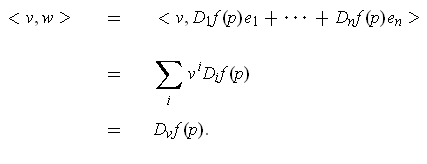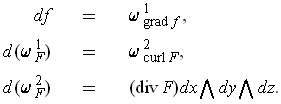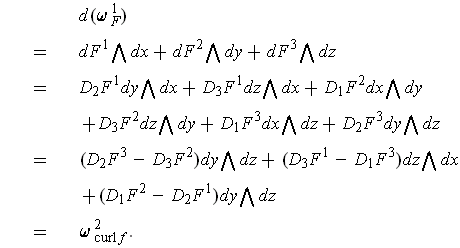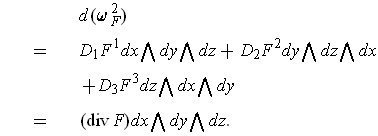- If
 and
and
 ,
show that
,
show that
 and
and
 .
.
The notation does not fully elucidate the meaning of the assertion. Here is the interpretation:

The second assertion follows from:

- If
 , show that
, show that
 .
.
One has by the definition and the product rule:

 be a differentiable curve in
be a differentiable curve in
 , that is, a
differentiable function
, that is, a
differentiable function
 . Define the
tangent vector
. Define the
tangent vector
 of
of
 at
at
 as
as
 . If
. If
 ,
show that the tangent vector to
,
show that the tangent vector to
 at
at
 is
is
 .
.
This is an immediate consequence of Problem 4-13 (a).
 and define
and define
 by
by
 . Show that the end point of the tangent
vector of
. Show that the end point of the tangent
vector of
 at
at
 lies on the tangent line to the graph of
lies on the tangent line to the graph of
 at
at
 .
.
The tangent vector of
 at
at
 is
is
 . The end point of
the tangent vector of
. The end point of
the tangent vector of
 at
at
 is
is
 which is certainly
on the tangent line
which is certainly
on the tangent line
 to the graph of
to the graph of
 at
at
 .
.
 be a curve such that
be a curve such that
 for all
for all
 . Show that
. Show that
 and the tangent vector to
and the tangent vector to
 at
at
 are
perpendicular.
are
perpendicular.
Differentiating
 , gives
, gives
 , i.e.
, i.e.
 where
where
 is the tangent vector to
is the tangent vector to
 at
at
 .
.
 , define a vector field
, define a vector field
 by
by

- Show that every vector field
 on
on
 is of the form
is of the form
 for some
for some
 .
.
A vector field is just a function
 which assigns to each
which assigns to each
 an element
an element
 . Given such
an
. Given such
an
 , define
, define
 by
by
 .
Then
.
Then
 .
.
- Show that
 .
.
One has
 .
.
 , define a vector field
, define a vector field
 by
by

For obvious reasons we also write
 . If
. If
 , prove that
, prove that
 and conclude that
and conclude that
 is
the direction in which
is
the direction in which
 is changing fastest at
is changing fastest at
 .
.
By Problem 2-29,

The direction in which
 is changing fastest is the direction
given by a unit vector
is changing fastest is the direction
given by a unit vector
 such thatt
such thatt
 is largest possible.
Since
is largest possible.
Since
 where
where
 , this is
clearly when
, this is
clearly when
 , i.e. in the direction of
, i.e. in the direction of
 .
.
 is a vector field on
is a vector field on
 , define the forms
, define the forms

- Prove that

The first equation is just Theorem 4-7.
For the second equation, one has:

For the third assertion:

- Use (a) to prove that

One has
 by part (a) and Theorem 4-10 (3); so
by part (a) and Theorem 4-10 (3); so
 .
.
Also,
 by part (a) and Theorem 4-10 (3); so the second
assertion is also true.
by part (a) and Theorem 4-10 (3); so the second
assertion is also true.
- If
 is a vector field on a star-shaped open set
is a vector field on a star-shaped open set
 and
and
 , show that
, show that
 for some function
for some function
 . Similarly, if
. Similarly, if
 , show that
, show that
 for some vector field
for some vector field
 on
on
 .
.
By part (a), if
 , then
, then
 . By the Theorem 4-11,
. By the Theorem 4-11,
 is
exact, i.e.
is
exact, i.e.
 . So
. So
 .
.
Similarly, if
 , then
, then
 and so
and so
 is closed. By Theorem 4-11, it must
then be exact, i.e.
is closed. By Theorem 4-11, it must
then be exact, i.e.
 for some
for some
 . So
. So
 as desired.
as desired.
 be a differentiable function with
a differentiable inverse
be a differentiable function with
a differentiable inverse
 . If every
closed form on
. If every
closed form on
 is exact, show that the same is true of
is exact, show that the same is true of
 .
.
Suppose that the form
 on
on
 is closed, i.e.
is closed, i.e.
 .
Then
.
Then
 and so there is a form
and so there is a form
 on
on
 such that
such that
 . But then
. But then
 and so
and so
 is also exact,
as desired.
is also exact,
as desired.
 is defined, we have
is defined, we have

Except when
 , the assertion is immediate from the definition of
, the assertion is immediate from the definition of
 in Problem 2-41. In case
in Problem 2-41. In case
 , one has trivially
, one has trivially
 because
because
 is constant when
is constant when
 and
and
 (or
(or
 ). Further,
L'H^{o}pital's Rule allows one to calculate
). Further,
L'H^{o}pital's Rule allows one to calculate
 when
when
 by
checking separately for the limit from the left and the limit from the right.
For example,
by
checking separately for the limit from the left and the limit from the right.
For example,
 .
.